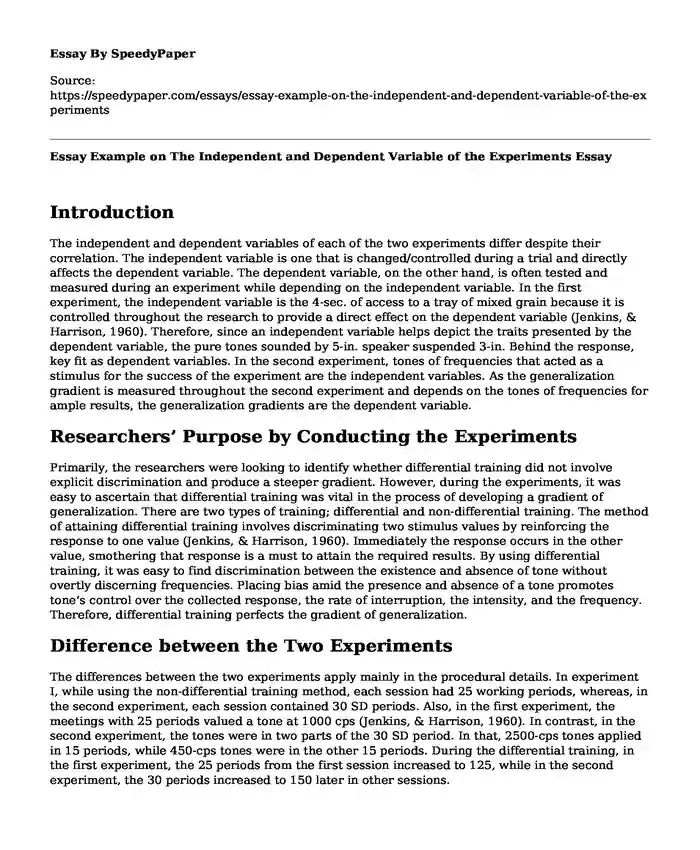
| Type of paper: | Essay |
| Categories: | Discrimination Research Social psychology |
| Pages: | 3 |
| Wordcount: | 644 words |
Introduction
The independent and dependent variables of each of the two experiments differ despite their correlation. The independent variable is one that is changed/controlled during a trial and directly affects the dependent variable. The dependent variable, on the other hand, is often tested and measured during an experiment while depending on the independent variable. In the first experiment, the independent variable is the 4-sec. of access to a tray of mixed grain because it is controlled throughout the research to provide a direct effect on the dependent variable (Jenkins, & Harrison, 1960). Therefore, since an independent variable helps depict the traits presented by the dependent variable, the pure tones sounded by 5-in. speaker suspended 3-in. Behind the response, key fit as dependent variables. In the second experiment, tones of frequencies that acted as a stimulus for the success of the experiment are the independent variables. As the generalization gradient is measured throughout the second experiment and depends on the tones of frequencies for ample results, the generalization gradients are the dependent variable.
Researchers’ Purpose by Conducting the Experiments
Primarily, the researchers were looking to identify whether differential training did not involve explicit discrimination and produce a steeper gradient. However, during the experiments, it was easy to ascertain that differential training was vital in the process of developing a gradient of generalization. There are two types of training; differential and non-differential training. The method of attaining differential training involves discriminating two stimulus values by reinforcing the response to one value (Jenkins, & Harrison, 1960). Immediately the response occurs in the other value, smothering that response is a must to attain the required results. By using differential training, it was easy to find discrimination between the existence and absence of tone without overtly discerning frequencies. Placing bias amid the presence and absence of a tone promotes tone’s control over the collected response, the rate of interruption, the intensity, and the frequency. Therefore, differential training perfects the gradient of generalization.
Difference between the Two Experiments
The differences between the two experiments apply mainly in the procedural details. In experiment I, while using the non-differential training method, each session had 25 working periods, whereas, in the second experiment, each session contained 30 SD periods. Also, in the first experiment, the meetings with 25 periods valued a tone at 1000 cps (Jenkins, & Harrison, 1960). In contrast, in the second experiment, the tones were in two parts of the 30 SD period. In that, 2500-cps tones applied in 15 periods, while 450-cps tones were in the other 15 periods. During the differential training, in the first experiment, the 25 periods from the first session increased to 125, while in the second experiment, the 30 periods increased to 150 later in other sessions.
Results and Implications of the Experiments
When looking at non-differential training in both experiments, increasing the training amount did not affect the gradient since the response strength had a shallow gradient. The responses from the first test to the second reduced since the main effects of stimuli were substantial and provided evidence of a shallow gradient during a non-differential training. The decline is due to not applying reinforcements while carrying out the generalization test. Differential training of the experiments recorded different results in that there was a well defining of gradients alongside the frequency (Jenkins, & Harrison, 1960). Opposite to the results in non-differential training, while carrying out differential training, there was attaining sharper angles with more robust responses that transpired at the rates strengthened during exercising. Stimuli interacting with blocks and tests in the experiments was due to change’s presence while spreading replies in successive blocks and successful trials. For that reason, the gradient is consistently sharpened from the first test onwards to the other during the experiments.
References
Jenkins, H. M., & Harrison, R. H. (1960). Effect of discrimination training on auditory generalization. Journal of Experimental Psychology, 59(4), 246. https://psycnet.apa.org/doi/10.1037/h0041661
Cite this page
Essay Example on The Independent and Dependent Variable of the Experiments. (2023, Oct 05). Retrieved from https://speedypaper.net/essays/essay-example-on-the-independent-and-dependent-variable-of-the-experiments
Request Removal
If you are the original author of this essay and no longer wish to have it published on the SpeedyPaper website, please click below to request its removal:
- Free Essay Sample on Steroid Use in Sports
- Brand Equity Essay Sample
- Free Essay: Political, Cultural and Religious Sociological Aspects of Missionaries
- Review of Motivating Employees. HR Essay Example.
- Free Essay Sample on Slave Ship
- Paper Example. Artists and Artworks
- Paper Sample on Spanish Invasion of Mexico
Popular categories




